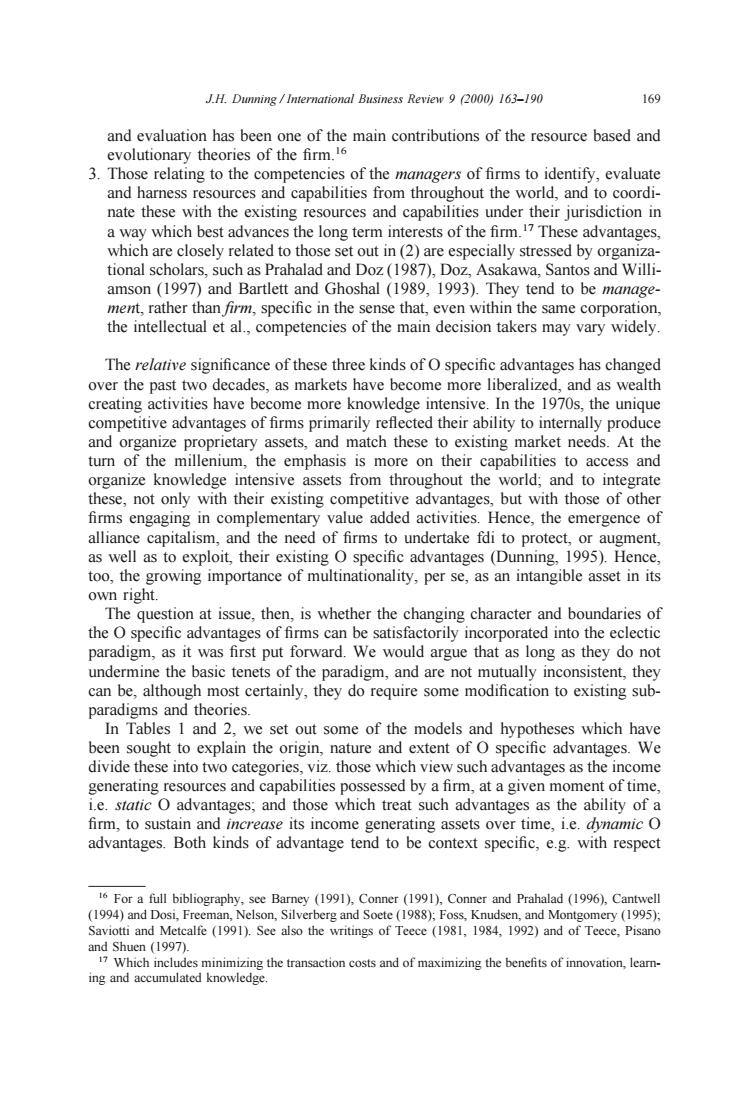正在加载图片...

JH.Dunning/Intermational Business Review 9000)163-190 69 of the main contributions of the resource based 3 ting to the con of the managers of fir nout th nate the the a way which best advances the long term interests of the firm.These advantages, which are closely related to those set out in(2)are especially stressed by organiza- tional scholars,such as Prahalad and Doz(1987),Doz,Asakawa,Santos and Willi- amson (1997)and Bartlett and Ghoshal (1989,1993).They tend to be manage ment,rather than firm,specific in the sense that,even within the same corporation the intellectual et al.,competencies of the main decision takers may vary widely The relative significance of these three kinds of O specific advantages has changed over the past two decades,as markets have become more liberalized,and as wealth and assets and match these to existing market needs. At the ium. the emphasis is more on their ca abilities to and ensive sets from not only ghout the with their existing co inte but those of engaging in comple ue added advar activ an to undertake fi to protect aswell as toexploit their existing specific advantagesDunng or augmen 995).Hence too,the growing importance of multinationality,per se,as an intangible asset in its own right. The question at issue,then,is whether the changing character and boundaries of the O specific advantages of firms can be satisfactorily incorporated into the eclectic paradigm,as it was first put forward.We would argue that as long as they do not undermine the basic tenets of the paradigm,and are not mutually inconsistent.they can be,although most certainly,they do require some modification to existing sub- paradigms and theories In Tables I and 2.we set out some of the models and hypotheses which have pdso u pu divide these into two categories generating resources and capabilitiesp sessed by a firr at a given moment of tin static o ady and thos which tr such adv as the ability firm.to sustain and se its i time,i.e. mic advantages.Both kinds of d to be e.g espect on.Silverberg and Socte ()Fos nev(1995 1992)and of Iccce,Pisano g the tro and of maximizing the of in ing and accumulated knowledge J.H. Dunning / International Business Review 9 (2000) 163–190 169 and evaluation has been one of the main contributions of the resource based and evolutionary theories of the firm.16 3. Those relating to the competencies of the managers of firms to identify, evaluate and harness resources and capabilities from throughout the world, and to coordinate these with the existing resources and capabilities under their jurisdiction in a way which best advances the long term interests of the firm.17 These advantages, which are closely related to those set out in (2) are especially stressed by organizational scholars, such as Prahalad and Doz (1987), Doz, Asakawa, Santos and Williamson (1997) and Bartlett and Ghoshal (1989, 1993). They tend to be management, rather than firm, specific in the sense that, even within the same corporation, the intellectual et al., competencies of the main decision takers may vary widely. The relative significance of these three kinds of O specific advantages has changed over the past two decades, as markets have become more liberalized, and as wealth creating activities have become more knowledge intensive. In the 1970s, the unique competitive advantages of firms primarily reflected their ability to internally produce and organize proprietary assets, and match these to existing market needs. At the turn of the millenium, the emphasis is more on their capabilities to access and organize knowledge intensive assets from throughout the world; and to integrate these, not only with their existing competitive advantages, but with those of other firms engaging in complementary value added activities. Hence, the emergence of alliance capitalism, and the need of firms to undertake fdi to protect, or augment, as well as to exploit, their existing O specific advantages (Dunning, 1995). Hence, too, the growing importance of multinationality, per se, as an intangible asset in its own right. The question at issue, then, is whether the changing character and boundaries of the O specific advantages of firms can be satisfactorily incorporated into the eclectic paradigm, as it was first put forward. We would argue that as long as they do not undermine the basic tenets of the paradigm, and are not mutually inconsistent, they can be, although most certainly, they do require some modification to existing subparadigms and theories. In Tables 1 and 2, we set out some of the models and hypotheses which have been sought to explain the origin, nature and extent of O specific advantages. We divide these into two categories, viz. those which view such advantages as the income generating resources and capabilities possessed by a firm, at a given moment of time, i.e. static O advantages; and those which treat such advantages as the ability of a firm, to sustain and increase its income generating assets over time, i.e. dynamic O advantages. Both kinds of advantage tend to be context specific, e.g. with respect 16 For a full bibliography, see Barney (1991), Conner (1991), Conner and Prahalad (1996), Cantwell (1994) and Dosi, Freeman, Nelson, Silverberg and Soete (1988); Foss, Knudsen, and Montgomery (1995); Saviotti and Metcalfe (1991). See also the writings of Teece (1981, 1984, 1992) and of Teece, Pisano and Shuen (1997). 17 Which includes minimizing the transaction costs and of maximizing the benefits of innovation, learning and accumulated knowledge